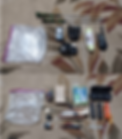When you are out in the field, the most important thing is...
Safety
Our group takes safety very seriously. Take care of yourself and be prepared while out searching for gold and enjoying nature. As a reminder, our group does not normally provide food or water on outings, and we are frequently in areas without cell service. Please tell others where you are going and how long you may be gone, and always come prepared.
This page is dedicated to all things safety - from your equipment to knowledge of the outdoors.
Click here to get your California fire permit here.
Interested in checking out Gold Getting Equipment? Click here to contact us and let us know!


Safety equipment in your pack
It's a great idea to pack items to take with you, even on short walks or hikes. Here is a basic list of suggested items to include in your pack, but of course, this is not an exhaustive list.
-
Basic First Aid kit, needed medications, small amount of dish soap (helps take away the oils from poison ivy and poison oak from skin)
-
Toilet paper and trowel to bury
-
Sun protection (sunscreen, hat, sun shirt)
-
California Fire Permit (also available virtually - simply include it on your smart phone). Get your California fire permit here.
-
Waterproof bag
-
GMRS radio, GPS device
-
Maps, monocular/binoculars, firestarter/lighter, bungee cord/rope, ink pen, magnifying glass, fixed blade knife, poncho/emergency blanket, spare glasses, whistle/compass, flashlight, extra batteries

Gold getting equipment in your pack
Here are some suggestions to help you feel more comfortable and prepared to find your next gold nugget!
-
Collapsable stool
-
Classifier, two gold pans, shovel
-
Crevacing tools, rock pick
-
Work gloves/neoprene gloves, knee pads
-
Suffer bottles, glass vials, suction device
-
Sluice box, bucket(s)


Wildlife
Being outside means hanging out with wildlife - from squirrels and birds, to snakes and mountain lions. Be aware and be prepared out there, and know some basics about the wildlife we have in the area and what to do if you encounter them.
In general, if you see or hear wildlife, leave it be. They are usally just curious and will leave you alone. If you feel threatened, the best thing to do is leave the area slowly. Never approach wildlife to try to touch it, pet it, or feed it. No matter how cute they are. Wildlife is unpredictable and a beautiful part of nature; our responsibilty is to keep us safe and them safe by leaving them where they are.
Some wildlife you might see...
-
If you see or hear a rattlesnake, do not get closer to it, poke it, or taunt it, simply leave the area. Rattlesnakes are dangerous and venomous - bites need to be treated immediately at a hospital.
-
If you see a mountian lion or mountain lion cubs, leave the area immediately.
-
If you see a bear or bear cubs, leave the area immediately. Do not try to feed them.
-
If you see a baby bird, leave it be - it's parents are likely close still caring for it.
-
If you see a bee hive or wasp's nest, stay away from the area.
If you see wildlife and want to let the world know what you saw, safetly snap a picture with your smartphone and upload it to iNaturalist - a great Citizen and Community Science Platform that keeps scientists well informed about what wildlife is being seen. It's a free website and app that anyone can use: Click here to learn more.
